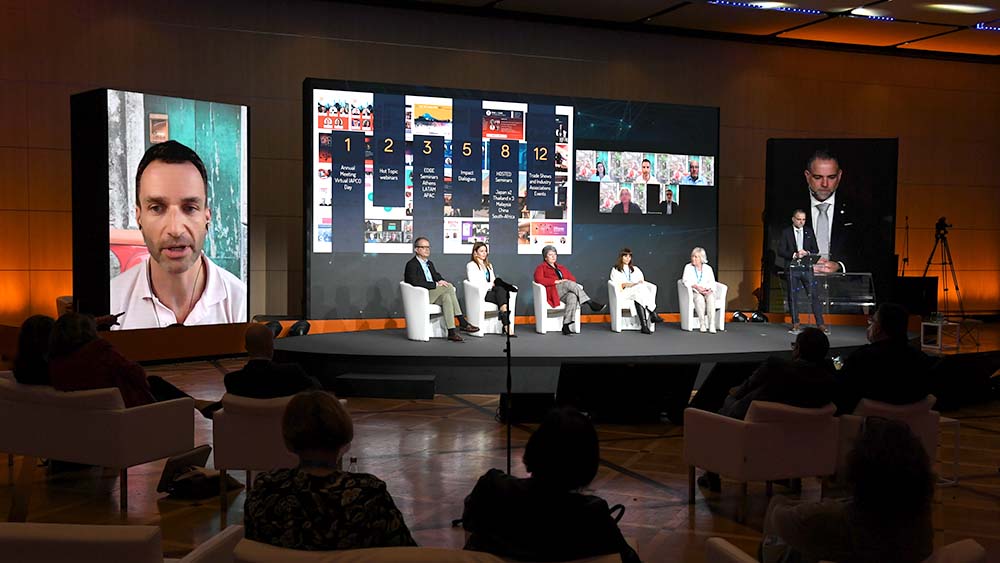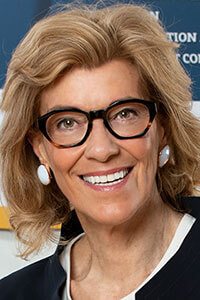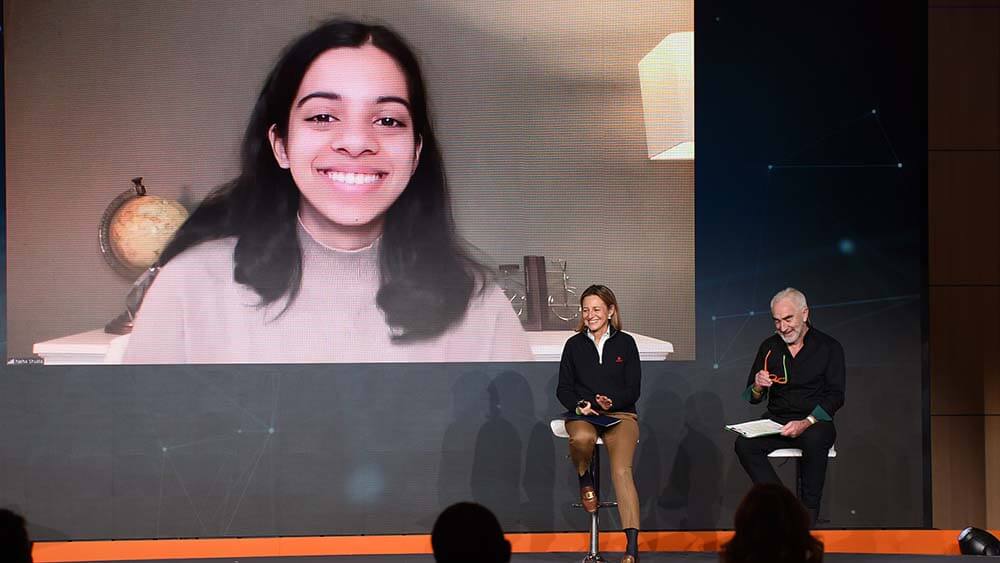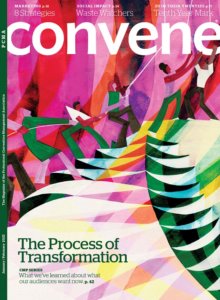
Some panels at IAPCO 2022 blended speakers who were physically at the meeting with remote panelists. (Photos courtesy of IAPCO)
Convene editors reached out to a handful of organizations to see how they are incorporating lessons learned from the ways the pandemic affected their audiences, stakeholders, and members into their go-forward strategies. This is one in a series of stories from the January/February issue of Convene.

Annalisa Ponchia
Annalisa Ponchia Baccara, CMP, CMM, was chief executive officer of the European Society for Organ Transplantation (ESOT) in 2010 when a series of eruptions of Iceland’s Eyjafjallajökull volcano shut down the airspace over northern Europe intermittently from April through May. Atmospheric ash from the volcano canceled the flights of hundreds of thousands of travelers — including those of speakers scheduled to attend ESOT’s annual meeting in Rotterdam in mid-April.
Zoom wouldn’t be on the scene for another year, but Skype was then at its peak. “And we said, ‘What if we call the speakers on Skype?’” recalled Ponchia Baccara, who is based in Padua, Italy, and now director of innovation and customer experience and director of international congress development at event services company AIM Group International. Speakers who couldn’t get to the conference emailed their presentation slides to ESOT to be projected onto a screen and narrated via Skype. “We invented hybrid, right then,” Ponchia Baccara said.
The sessions weren’t broadcast, and only benefitted the attendees who could make it to the conference in Rotterdam, but it was an early lesson in how technology can illuminate and enable new ways of making connections, she said. After the exponential growth of online meetings in the last three years, the challenge facing the industry now, Ponchia Baccara said, is distilling the best lessons from the hundreds learned from the forced shift to digital during the pandemic and carrying them forward.

Neha Shukla, an 18-year-old inventor and author, appeared remotely at IAPCO 2022.
Ponchia Baccara is not a fan of the view that digital was just a temporary fix — nor the opposite view that the trend is now toward all-digital, she said. At AIM Group, “our purpose is to kind of break through the mindset of one or the other. The real lessons [from the pandemic] are in how digital can support sustainable events and inclusivity,” she said, “so that we are offering opportunities to people who would not otherwise travel or could not otherwise be present.” And the trend, she added, is toward leveraging the most modern technology on stage to reach those goals.
In the future, speakers may be remote, not because they can’t travel, but because it’s not sustainable for someone to “travel eight hours just to present for 15 minutes,” she said. And while there’s undeniable value in the human connection and networking that comes from attending a meeting in person, Ponchia Baccara said, “for a young investigator or doctor, digital may represent the only chance to be at conference — otherwise, [they must] stay home and don’t participate at all.”
As a good example of how remote and in-person attendees and speakers can be successfully blended, Ponchia Baccara pointed to the Annual Meeting and General Assembly (AM&GA) of the International Association of Professional Congress Organisers (IAPCO), held in February 2022 in Rome. Organized by AIM and other industry partners, it offered a mix of formats tailored to speaker and attendee preferences and availability: Some keynotes were remote, and panels blended speakers who were physically at the meeting with remote panelists, she said. The association was able to make it feel seamless to both in-person and remote attendees by using high-quality AV and multiple large screens, she said. Panelists were projected onto screens that were arranged in a semi-circle, “so that they looked like they were sitting with us,” said Ponchia Baccara, who organized the education program and also acted as a moderator for some sessions.
Her top recommendations for making the most of hybrid? “Create the best experience you can and use that in support of sustainability and accessibility. And, obviously, use the best technology you can afford. And experiment. We have been using digital as a surrogate for in-person meetings, but really haven’t experimented enough with hybrid.”
Barbara Palmer is deputy editor of Convene.
ON THE WEB
Download a special issue of IAPCO’s The PCO, with takeaways from IAPCO 2022.

The Complete January/February CMP Series
- AMDA’s Journey to Meeting Back In Person
- Medical Society Finds Success by Getting Uncomfortable
- How Short-Term Activations Can Create Lasting Positive Change
- Breaking Through the Mindset of Digital vs. In-person Events
- Finding the ‘Sweet Spot’ for Anesthesiologist Group’s Annual Meeting
- Science Group’s Hybrid Meetings Improve Access, Affordability
- Acquisition of a Fan Expo Opens Doors for Nonprofit
